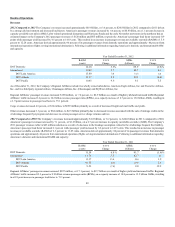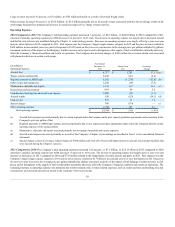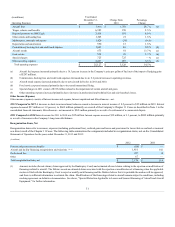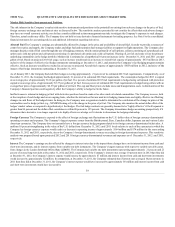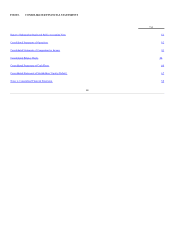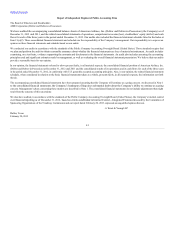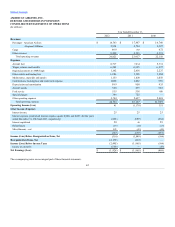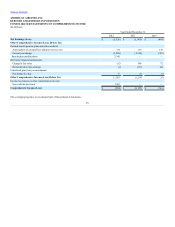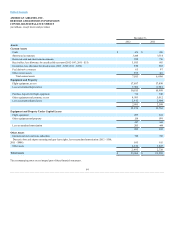American Airlines 2012 Annual Report Download - page 54
Download and view the complete annual report
Please find page 54 of the 2012 American Airlines annual report below. You can navigate through the pages in the report by either clicking on the pages listed below, or by using the keyword search tool below to find specific information within the annual report.
Table of Contents
assets may be impaired, the undiscounted cash flows estimated to be generated by those assets are less than the carrying amount of those assets and the net
book value of the assets exceeds their estimated fair value. In making these determinations, the Company uses certain assumptions, including, but not limited
to: (i) estimated fair value of the assets; and (ii) estimated future cash flows expected to be generated by the assets, generally evaluated at a fleet level, which are
based on additional assumptions such as asset utilization, length of service and estimated salvage values. A change in the Company’s fleet plan has been the
primary indicator that has resulted in an impairment charge in the past.
The majority of American’s fleet types are depreciated over 30 years. It is possible that the ultimate lives of the Company’s aircraft will be significantly
different than the current estimate due to unforeseen events in the future that impact the Company’s fleet plan, including positive or negative developments in
the areas described above. For example, operating the aircraft for a longer period will result in higher maintenance, fuel and other operating costs than if the
Company replaced the aircraft.
In the second quarter of 2011, American entered into agreements with Airbus S.A.S. (Airbus) and The Boeing Company (Boeing) under which it plans to
acquire 460 narrowbody aircraft from the Boeing 737 and Airbus A320 families during the period 2013-2022. In connection with these Boeing and Airbus
aircraft agreements and the Company’s anticipated acceleration of its fleet renewal and replacement plan, the Company recorded an impairment charge in 2011
to write its Boeing 757 aircraft and certain related long-lived assets down to their estimated fair values. For further information regarding the Boeing and
Airbus agreements, see Note 17 to the consolidated financial statements.
International Slots and Route Authorities
The Company performs annual impairment tests on its international slots and route authorities, which are indefinite life intangible assets and as a result they
are not amortized. As discussed above, the Company also performs impairment tests when events and circumstances indicate that the assets might be
impaired. These tests are primarily based on estimates of discounted future cash flows, using assumptions based on historical results adjusted to reflect the
Company’s best estimate of future market and operating conditions. The net carrying value of assets not recoverable is reduced to fair value. The Company’s
estimates of fair value represent its best estimate based on industry trends and reference to market rates and transactions.
The Company had recorded international slots and route authorities of $708 million as of December 31, 2012. The Company estimates the fair value of these
assets based on market information and estimated future cash flows. The Company believes its estimates and assumptions are reasonable; however, given the
significant uncertainty regarding how open skies agreements will ultimately affect the Company’s operations at Heathrow and Narita, and other international
locations that are evaluating “open skies”, as well as volatility in the revenue and fuel environment, the actual results could differ from those estimates. See
Note 12 to the consolidated financial statements for additional information regarding the valuation of the Company’s routes.
Passenger revenue
Passenger ticket sales are initially recorded as a component of Air traffic liability. Revenue derived from ticket sales is recognized at the time service is
provided. However, due to various factors, including the industry’s pricing structure and interline agreements throughout the industry, certain amounts are
recognized in revenue using estimates regarding both the timing of the revenue recognition and the amount of revenue to be recognized, including breakage.
These estimates are generally based upon the evaluation of historical trends, including the use of regression analysis and other methods to model the outcome
of future events based on the Company’s historical experience, and are recognized at the scheduled time of departure. The Company’s estimation techniques
have been applied consistently from year to year. However, due to changes in the Company’s ticket refund policy and changes in the travel profile of
customers, historical trends may not be representative of future results.
Frequent flyer program
American uses the incremental cost method to account for the portion of its frequent flyer liability incurred when AAdvantage members earn mileage credits by
flying on American or its regional affiliates.
The Company considers breakage in its incremental cost calculation and recognizes breakage on AAdvantage miles sold over the estimated period of usage for
sold miles that are ultimately redeemed. The Company calculates its breakage estimate using separate breakage rates for miles earned by flying on American
and miles earned through other companies who have purchased AAdvantage miles for distribution to their customers, due to differing behavior patterns.
Management considers historical patterns of account breakage to be a useful indicator when estimating future breakage. Future program redemption
opportunities can significantly alter customer behavior from historical patterns with respect to inactive accounts. Such changes may result in material changes
to the frequent flyer liability, as well as recognized revenues from the program.
American includes fuel, food, and passenger insurance costs in the calculation of incremental cost. These estimates are generally updated based upon the
Company’s 12-month historical average of such costs. American also accrues a frequent flyer liability for
54







